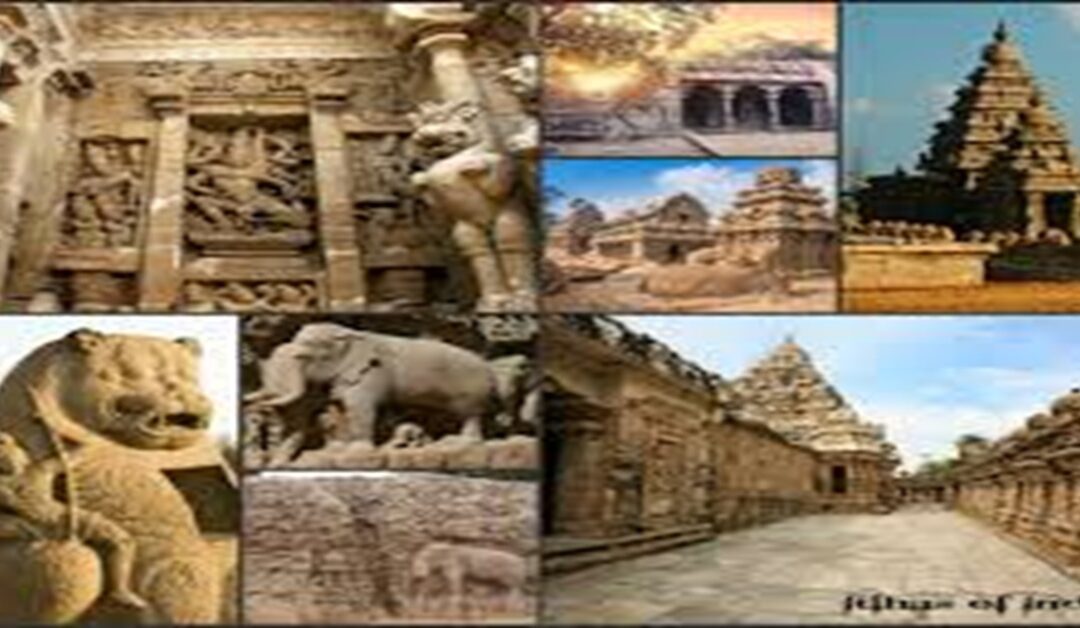The Pallava king was an art lover and patronized art and architecture immensely. As a result, a new style emerged in Indian art history. This style is called ‘Dravidian style’. The best art monuments were built during the Pallava period, following the Dravidian style. Pallava architecture can be divided into 2 parts according to its development.
1. Cave temples,
2. Temples,
1. Cave temples:
Cave temples can be divided into two categories.
a) Stambhamantapas,
b) Monolithic temples.
a) Stambhamantapas:
Since this style developed during the reign of Mahendravarman I, it is also called the Mahendravarman style. The cave temples of Stambhamantapas are found on a 100-foot-high rock hill in Mahabalipuram. Brick, wood, metal or mortar were not used in the construction of Stambhamantapas. Simple pillared mantapa containing one or two sanctuaries. The main feature of this style is that the front of the pillared mantapa contains a row of seven feet pillars.
b) Monolithic temples:
This style is known as the Narasimhavarman style because it developed during the time of Narasimhavarman. Mantapa carved in this style are found in Mahabalipuram. The 8 most important such chariots are Bhima, Arjuna, Dharmaraya, Nakula, Sahadeva, which are named after the Pancha Pandavas, while the other two are Ganesha Ratha and Ollaiyan Kutti Ratha. The longest and most complete chariot is Dharmaraja Ratha. It shows features of the Pallava style. Bhima, Ganesha and Sahadeva Ratha are carved in a square shape. They consist of two and three stories. The Draupadi Ratha is the smallest chariot, while the Bhima Ratha is the largest. Each chariot is made of a single solid rock and each chariot has the design of a temple.
2. Temples:
The temples of the Pallava period can be divided into
a) Rajasimha style,
b) Aparajita style temples.
a) Rajasimha style:
Rajasimha was the author of this style. The works of art of this style are the coastal temple in Mahabalipuram, the Ishwara temple and the Mukunda temples, the Kailasanatha temple built in bronze and the Vaikuntha Perumal temple are temples with tall towers in this style. The sculptures of such temples contain full-length idols of kings and queens.
Shore Temple:
The ‘Shore Temple’ in Mahabalipuram is one of the important temples of the Pallava period. The important features of the Pallava architectural style are seen in this temple. The temple, which is located in the sea, has been damaged by the waves due to the storm. The Kailasanatha temple has a pyramidal spire, a flat bhavaniya mantapa and lions carved on the pillars of the mantapa. The temple consists of a front hall, a hall and a sanctum sanctorum in the Pallava style. All the features of the Pallava style are seen in this temple. Granite stone is used for the lower part of the temple. Sandstone is used for the upper part.
The Vaikuntha Perumal temple is larger than the Kailasanatha temple. The temple consists of a sanctum sanctorum, antarala and a front hall. A gopuram is found above the sanctum sanctorum.
b) Aparajita style:
The buildings belonging to the 9th century AD are identified as ‘Aparajita style’ and are called by the same name. The Aparajita style is a clear example of Chola art. In this style, the lingas are built in a circular shape.
Sculpture:
Sculpture also developed during the Pallava period, the best example being the ‘Devagangeya Bhusparsha’ or ‘Gangavatarana’ sculpture at Mahabalipuram. The sculpture is carved in a single block of stone. The block is 99 feet long, 45 feet wide and 30 feet high.
Mahendravarman I was given the title ‘Chittakarapuli’ (Tiger among painters) because he greatly encouraged painting. The scenes of Anantashaya, Mahishasuramardini and Lord Krishna holding up Govardhana in the Mantapa of Mahabalipuram are a sight to behold.
The development of mural painting can be seen in the cave temples of the Pallava period. There are paintings of Apsaras in dancing postures at Sittannavasal.
Conclusion:
After observing the art development of the Pallavas of Kanchi, the famous art expert ‘Persi Brown’ opined that the Pallavas laid the foundation for the development of the art style of South India. V.A. Smith has said that ‘the history of architecture and sculpture in South India began at the end of the 6th century’.
Overall, the Pallava period is considered to be a period of cultural splendor.

